Tired of Guessing? Top 10 Competitor Analysis Tools That Deliver Insights in 2025
Guessing which competitor creatives work wastes time and ad dollars. Manual screenshots, spreadsheets, and occasional audits often struggle to keep pace with the speed and volume of modern ad launches.
That gap means missed test ideas, slow creative turns, and campaigns that trail competitors. Today’s tools index live ads, capture creatives and metadata like placements and landing pages, and surface spend and timing signals so teams stop guessing and start testing faster.
Tools also pull multi-channel assets such as emails and landing pages so that you can compare whole funnels rather than single ads. With AI and faster indexing, many platforms now return fresh examples within hours and offer tagging or automated suggestions to help pick testable ideas.
Use focused competitor ad analysis tools to save hours of manual work and to feed high-confidence creative testsinto your user acquisition workflow. Pick tools that match the channels you run on, give recent creatives with landing pages, and make it quick to turn those examples into hypothesis-driven tests.
In this blog, we will explain what competitor ad analysis gives you, compare traditional and AI-powered approaches, list the top tools people use in 2025, and finish with a short 4-week plan to add competitive benchmarking into your team’s routine.
What Is Competitor Ad Analysis?
Competitor ad analysis involves collecting and studying your rivals’ ad activity to identify what works and what doesn’t, allowing you to replicate successful strategies. You get examples of creatives (images, video, headlines), where those ads run (placements and networks), the landing pages they send traffic to, signals about spend and cadence (how long ads run and how often), plus keywords and search ads when available.
Why does this matter? Meta’s 2025 creative-optimization research notes that campaigns using AI-assisted creative assets produced an ~11% higher click-through rate and ~7.6% higher conversion rate in internal tests, a clear signal that learning what competitors are testing (and whether they use AI in their creatives) can meaningfully impact performance.
Competitive analysis generally spans five areas: product offerings, pricing strategies, promotional tactics, distribution channels, and overall market performance. Gaining insights into these areas can directly inform and strengthen your ad campaigns. That said, there are challenges to be aware of, such as incomplete data, privacy concerns, and the risk of misinterpreting competitor strategies without proper context.
From Traditional to AI-Powered Competitor Ad Analysis
While traditional competitor analysis relies on manual tracking and observation, AI-powered tools transform how you collect and apply data. Instead of piecing together insights by hand, AI tools automate monitoring, detect patterns across multiple channels, and provide actionable recommendations. The difference is not just speed; AI also enables more precise and data-driven decisions. Here’s a side-by-side comparison:
Aspect | Traditional (Manual Approach) | AI-Powered (Modern Approach) |
|---|---|---|
Setup Time | Gathering screenshots, checking ad libraries, and building reports can take days or even weeks. | Tools track and organize ads automatically, providing you with updated dashboards within hours. |
Data Sources | Limited to public sources, such as Meta Ad Library, or examples found manually. | Pulls data from multiple ad networks, landing pages, and past campaigns across platforms at once. |
Update Frequency | Insights remain static until manually checked, which means new ads may be missed. | Data refreshes daily or proactively, with alerts for new creatives or significant shifts in spending. |
Scale & Coverage | Tracking more competitors means more manual effort and people. | You can monitor hundreds of brands simultaneously with the same setup, without any extra workload. |
Accuracy & Bias | Manual tagging and sorting can miss context or include personal bias. | Machine learning processes data consistently, making results objective and easier to compare. |
Insight Type | Shows what ran and when, valuable but limited to past activity. | Detects trends, predicts creative fatigue, and uncovers audience overlap for proactive strategy. |
Speed to Action | Reports require manual cleaning and sharing, which slows down the creative testing process. | You can instantly spot new ideas and send them directly into your next ad iteration cycle. |
Cost & Resources | Although cheap, the tools incur a significant time cost due to the team hours spent collecting and organizing data. | Paid subscription, but it saves weeks of labor and gets insights ready to use faster. |
Privacy & Compliance | Easier to control because you collect data manually. | Most AI tools adhere to platform rules, including data usage policies and privacy standards such as GDPR or CCPA. However, it is essential to verify vendor certifications and compliance statements to ensure data security. |
Best Use Case | Works fine when tracking a few competitors occasionally. | Ideal for situations requiring continuous monitoring and quick exploration of creative or targeting ideas. |
Whether you choose a manual workflow or an AI platform, the real benefit lies in what you can do with the insights. The following key advantages highlight the specific benefits teams typically gain.
Key Benefits of Competitive Ad Analysis
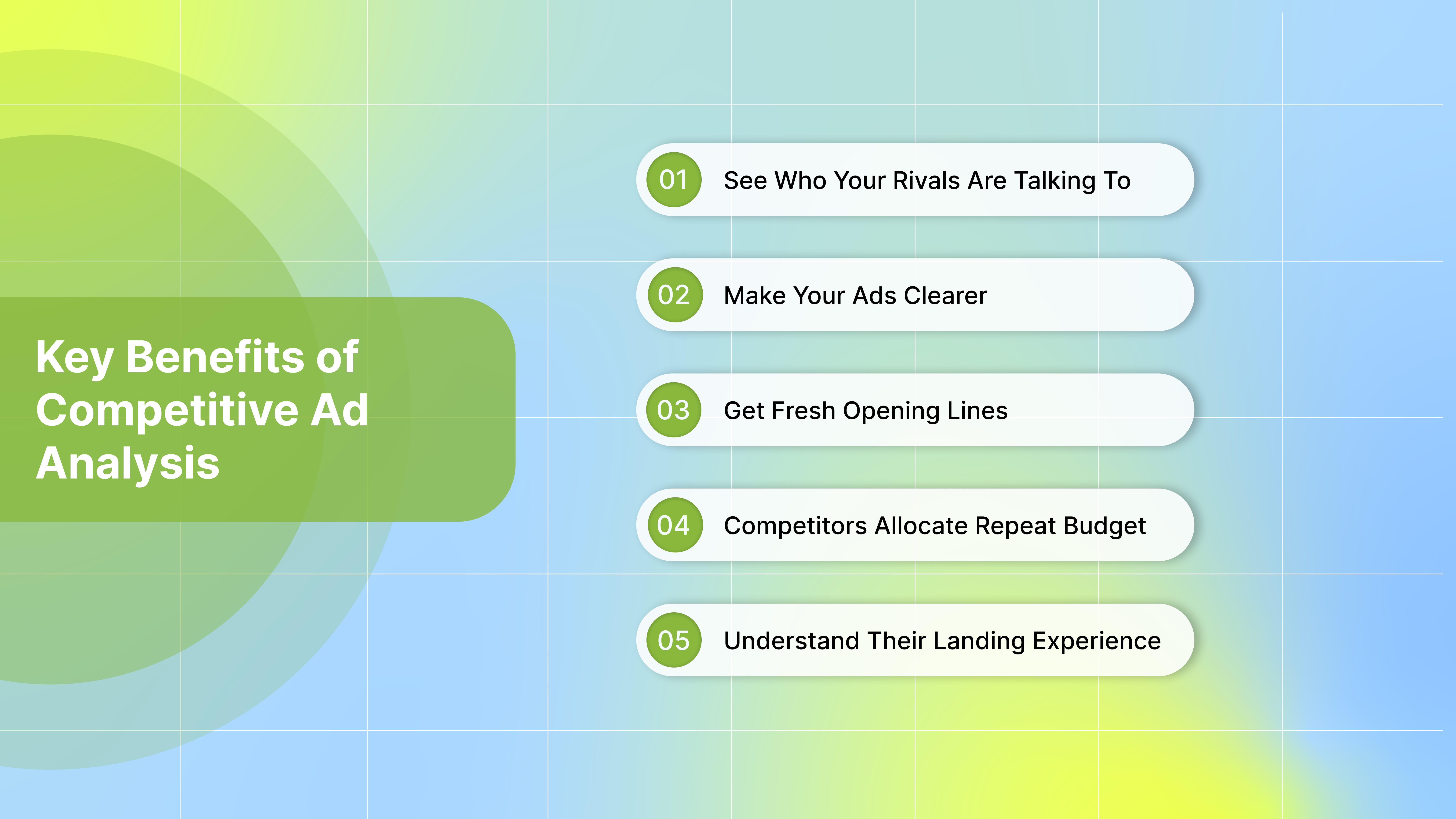
Here’s what you can gain when you monitor competitors effectively:
See who your rivals are talking to: You can spot the platforms, regions, and audience types competitors favor. That tells you where demand is being chased and where there may still be room to test a different message or placement. Use those signals to choose where to put your next experiments.
Make your ads clearer and faster to learn from: By studying patterns in visuals, tone, and calls-to-action, you quickly identify which creative elements capture attention. Copy the structure, not the copy: borrow formats and test your own words and images that match your product.
Get fresh opening lines and angles to test: By watching how other teams hook people, you can gain immediate A/B tests, new hooks, different offers, or altered first-frame visuals to spin up without guessing. This keeps your creative calendar full.
Identify where competitors allocate repeat budget: Ads that run for an extended period or appear across multiple placements are likely backed by budget. That’s a clue about what’s working for them and where you may need to match or out-differentiate. Use repeat patterns to set your own bids and budgets more intelligently.
Understand their landing experience: Open competitors’ landing pages and funnels to learn how they present offers, place CTAs, and structure the path from click to conversion. This often reveals small changes that can be tested to improve conversion without a major creative overhaul.
Modern AI tools simplify this process by letting you search, filter, and save examples quickly. This cuts hours of manual work, allowing you to move new ideas into experiments faster and learn what truly drives results.
If those benefits sound useful, here are the top eight tools that help capture and turn those signals into tests and decisions.
Top 8 Competitor Ad Analysis Tools in 2025
Turning competitor insights into real results starts with using the right tools. Each one brings something different; some help you spot new ad creatives, others reveal full funnels, keyword shifts, or spending trends. The list below outlines the top tools for 2025, explaining how each can help you transition from insight to confident action.
1. Segwise.ai
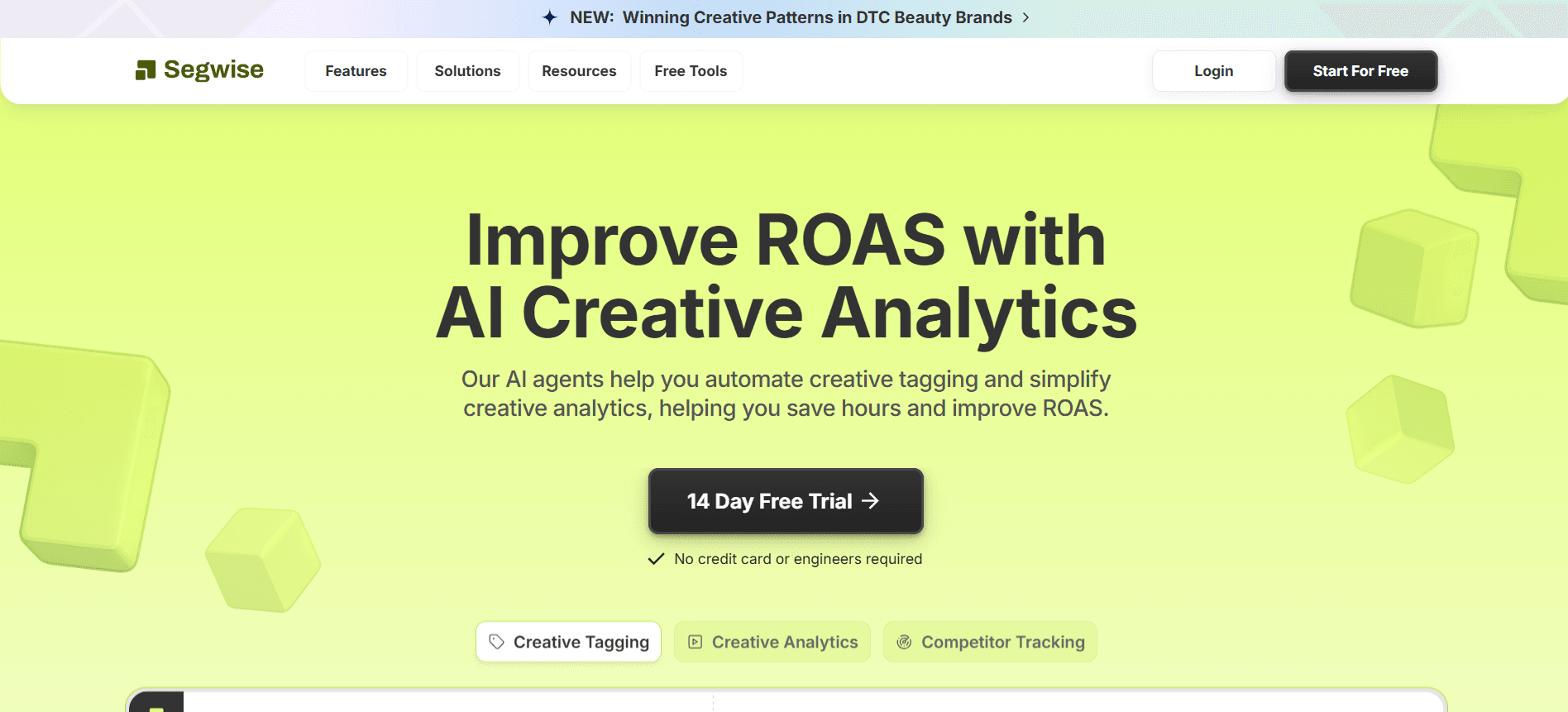
Segwise is an AI-powered creative analytics platform that offers a free Meta Ad Library tracker, enabling users to monitor up to five competitors' Meta (Facebook and Instagram) ads in real time. The tool continuously scans the Meta Ad Library, providing a clean, 7-day rolling dashboard that displays newly launched ads and keeps users informed about competitors' latest campaigns without manual searching.
Core capabilities:
Real-time scanning of the Meta Ad Library (new ads appear within hours).
7-day rolling dashboard that lists only the most recent ads.
Track up to five competitors in one place for side-by-side comparison.
Saves around 10+ hours every week by removing manual Meta Ad Library searches.
Free forever, with a quick setup that lets you start tracking in under two minutes.
How Segwise analyzes competitors:
Segwise’s free Meta Ad Library tracker delivers enterprise-grade visibility without a price tag. Powered by Segwise’s multimodal AI tagging engine, it labels hooks, CTAs, and emotions so UA teams instantly see which trends drive results.
When upgraded, these same AI foundations extend into cross-network analytics, MMP integrations, and fatigue detection, creating a unified creative-intelligence system designed to give marketers deeper visibility and faster decisions than any other tool.
Best for:
Teams that need fast visibility into fresh Meta creatives (the free tracker).
Growth and UA teams at apps/games that want to move from intuition to element-level hypotheses (e.g., “ads with a character + X CTA outperform others”) by combining creative tags with performance metrics.
Pricing:
The Meta Ad Library tracker is free, tracks up to five competitors, and does not require a credit card.
2. Panoramata
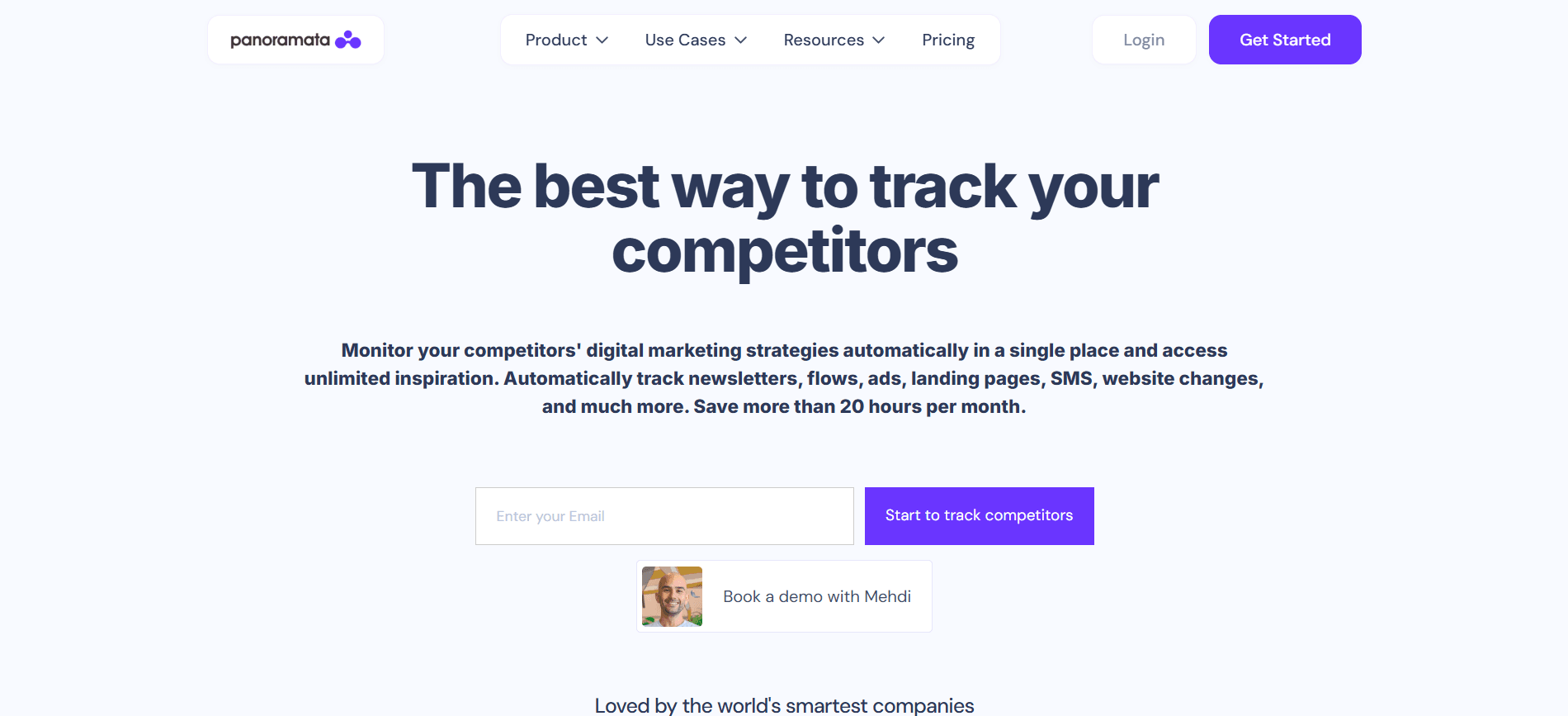
Panoramata archives full marketing journeys, ads, landing pages, emails, flows, SMS, and catalog/pricing shifts and timestamps every change so you can compare sequences and reuse proven funnel elements. It gives daily and weekly summaries, side-by-side archives, and flow playback to reconstruct sequences.
Core capabilities:
Multi-channel capture (social/display ads, landing pages, email flows, SMS, pricing/catalog changes).
Change alerts include daily and weekly summaries, as well as timeline comparisons.
Side-by-side archive and benchmark views for messaging, layout, and funnel sequencing.
Snapshots and replays of landing-page flows enable teams to reconstruct variants quickly.
How Panoramata analyzes competitors:
Panoramata continuously archives tracked domains and public pages. It records changes (visual and textual), builds a timeline for each asset, and shows comparisons and benchmarks so you can spot tested hooks, conversion flows, or price moves.
Best for:
If you're looking for proven funnel elements and messaging sequences to replicate or A/B test quickly across landing pages and emails.
Pricing:
Startup: $99/month (billed monthly), includes 6 months of historical data and basic competitor tracking.
Professional (most popular): $179/month (billed monthly), up to 3 years of historical data, 10 users, and full access to marketing asset searches.
Advanced: $399/month (billed monthly) unlimited brand tracking, 20 users, ideal for agencies and large companies.
Enterprise: Custom pricing, tailored plans, and data points for larger teams.
3. Bestever.ai
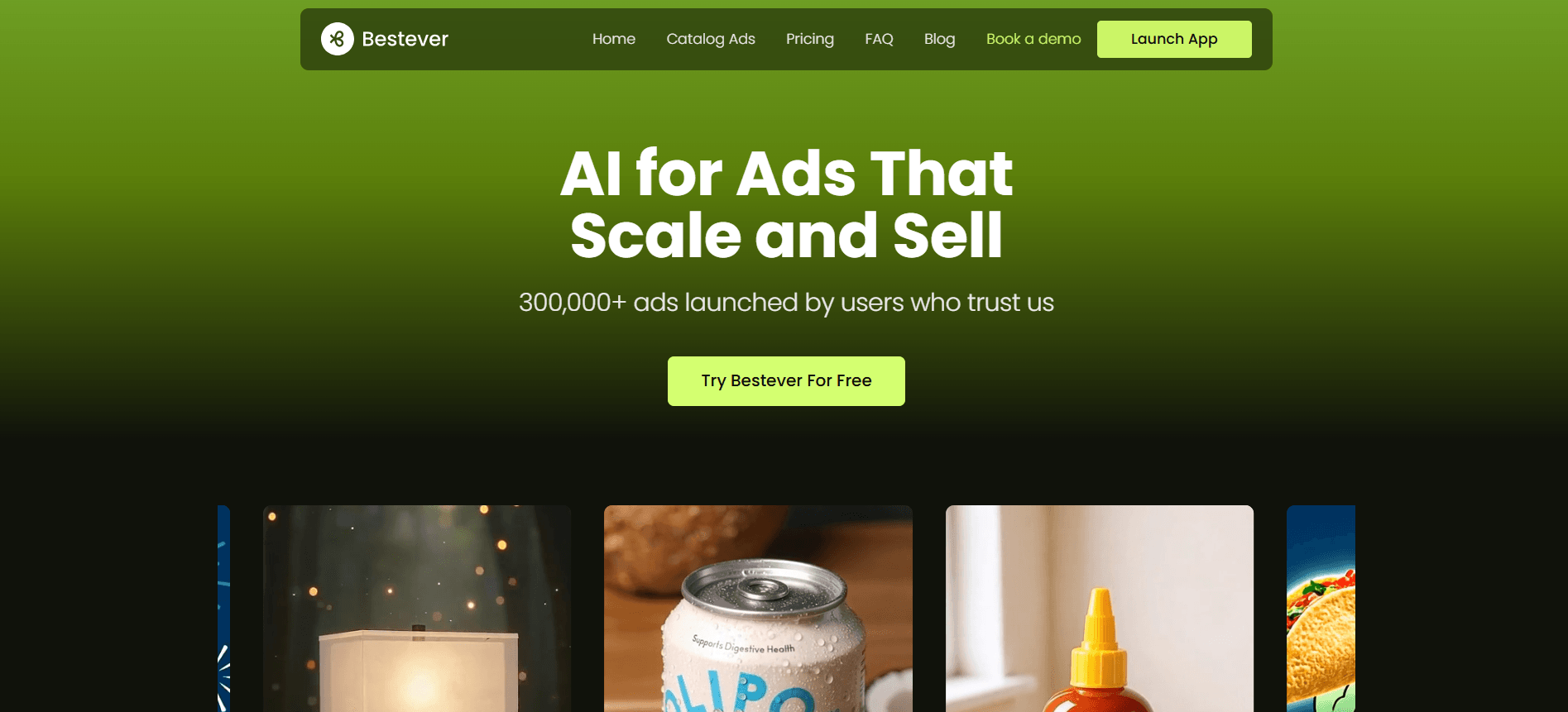
Bestever combines creative analysis with AI-assisted generation for short image and video ads. It ingests public creatives and connected ad accounts to surface recurring elements, then suggests or generates testable variants (credits and output limits depend on plan). That makes it a good fit when you need both insight and fast creative drafts.
Core capabilities:
Ingests connected ad accounts (Meta, LinkedIn, etc.) and public creatives for pattern analysis.
Automated tagging and creative scoring to highlight recurring winning elements.
AI generation of image and short video ad variants, with credits/limits by plan.
Creative briefs and storyboard outputs to hand to designers or video editors.
How Bestever.ai analyzes competitors:
Bestever pulls available creative assets and performance signals (if you connect your accounts), tags recurring visual and messaging elements, and suggests variant prompts or finished outputs you can test. The system ranks elements that correlate with better performance.
Best for:
Ideal for rapid variants in A/B tests, but generated assets may require design polish for brand safety and pixel-perfect composition.
Pricing:
Free ($0): 120 credits (expires in 14 days). Includes competitive analysis, LinkedIn post generation, static creative generation & editing, automated creative tagging, and data/creative reports.
Images Standard ($39 /month): 300 credits per month; everything is Free at higher volumes. (No video generations.)
Videos Essential ($79 /month): 675 credits per month, up to 180 seconds of video generation, plus unlimited image generations and all Images Standard features.
4. Adbeat
Adbeat offers display and native ad intelligence, mapping creatives to the publishers they run on and estimating buy types (programmatic, direct, native network). It’s valuable when you want publisher-level visibility and inferred spend signals to plan placement tests.
Core capabilities:
Large archive of display and native creatives indexed by publisher and ad network.
Publisher placement lists and inferred buy types (programmatic vs direct).
Estimated ad-spend signals, alerts, and exportable reports for ongoing monitoring.
How Adbeat analyzes competitors:
Adbeat indexes creatives, mapping them to publisher domains and ad networks. It then uses signal patterns and historical data to estimate buy types and relative spend, allowing you to identify where competitors are active and which formats perform best on which publishers.
Best for:
Helpful in evaluating publishers before you allocate test budget. The spend estimates are directional, not exact ad-account statements.
Pricing:
Standard ($249/month): Includes all display, programmatic, and native ads. Search by keyword, filter by device, date range, or ad network, and access ads from 35 countries. Get 1,000 results per search with 90 days of data, view publisher URLs, and export reports.
Advanced ($399/month): Adds country-level filters, competitor alerts, comparison reports, unlimited search results, one year of data, and visibility into direct publisher buys.
Enterprise (Custom pricing (contact sales)): Adds estimated ad spend, category-level insights, campaign performance views, advanced reporting, smart alerts, ad paths, and access to pre-roll video ads with up to three years of data.
5. SpyFu
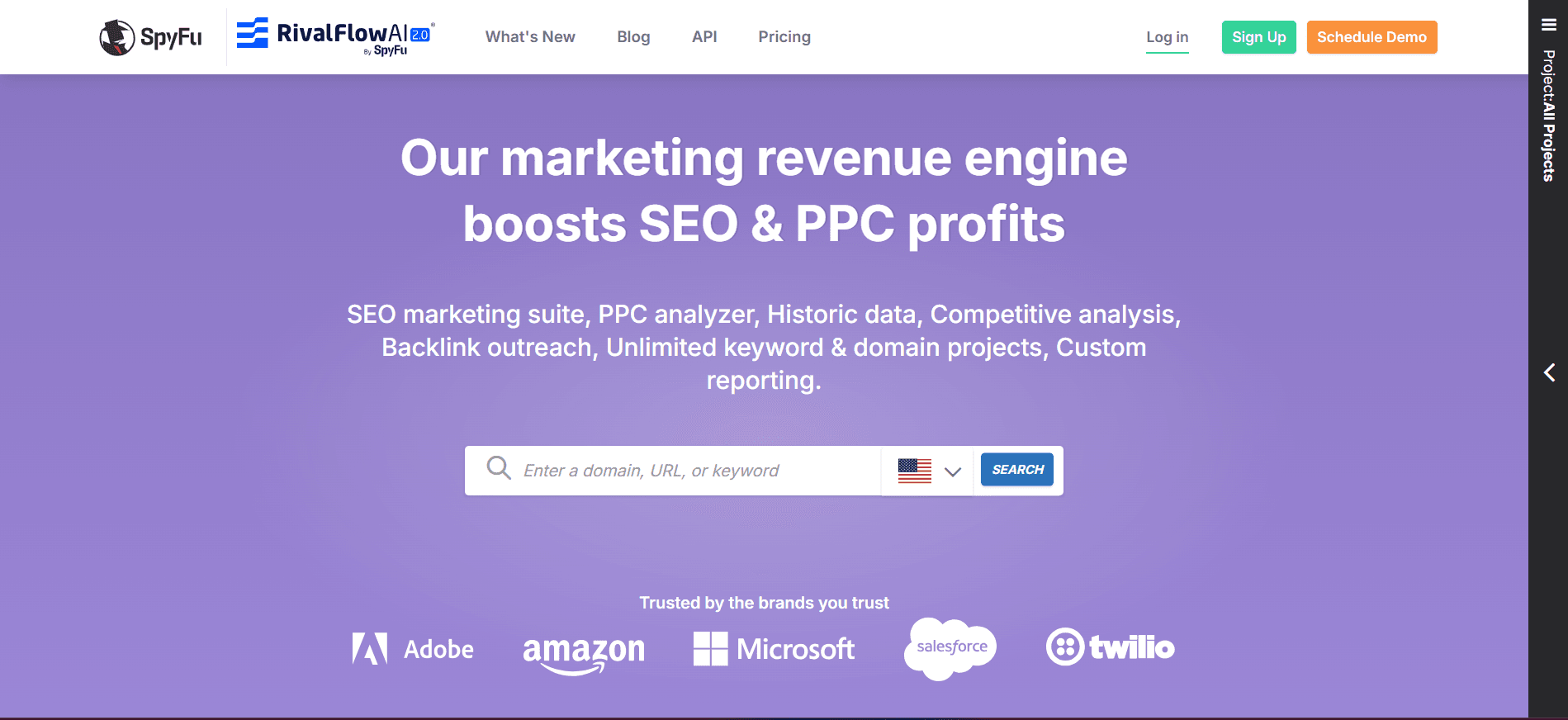
SpyFu concentrates on search intelligence for both paid and organic. It reveals historical keywords competitors have bought, ad-copy versions, and organic rank trends, which helps with bidding strategy and ad-text experiments. SpyFu’s long historical archive makes it helpful in spotting keyword moves over time.
Core capabilities:
Historical paid keyword lists, ad copy archives, and organic rank history that can go back many years.
Rank-tracking and competitor keyword-overlap reports to find gaps and low-competition opportunities.
Exportable keyword lists and branded reporting for audits and hand-off to PPC teams.
How SpyFu analyzes competitors:
SpyFu crawls search results and gathers historic ad placements, grouping paid keywords and ad copy by domain. That shows which keywords rivals invested in and how their messaging changed over time.
Best for:
Strong for search strategy and keyword discovery; native account-level metrics (clicks, conversions) still come from your own ad platform.
Pricing:
Basic: $39 per month or $29 per month billed annually. Includes 10k searches, 1 project, limited AI, and ad history.
Pro with AI: $59 per month or $89 per month billed annually. Includes unlimited searches, 10 projects, full ad history, and 15k tracked keywords.
Team: $249 per month or $187 per month billed annually. Includes unlimited access, 50k tracked keywords, and 5 users.
6. AdPlexity
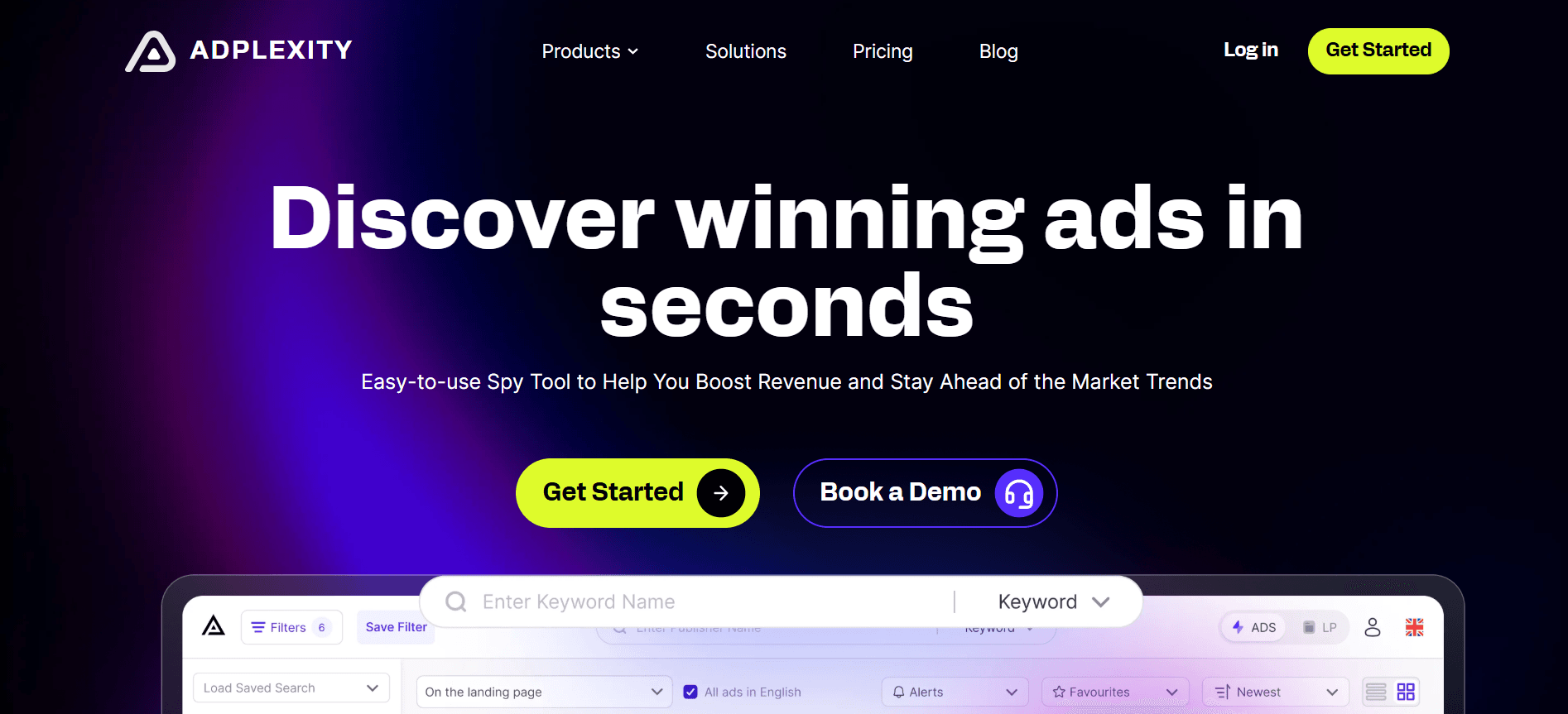
AdPlexity is built for cross-channel ad spying, including native, push, mobile, desktop, and affiliate funnels. It stores funnel and landing-page snapshots, allowing you to rebuild high-ROI flows for testing. Module-based pricing means you can buy only the channels you need.
Core capabilities:
Cross-channel scraping (native, push, mobile, desktop) with device and country filters.
Landing page and funnel capture to replay or rebuild top-performing flows.
Historic data access per module, allowing you to inspect past top creatives and offers.
How AdPlexity analyzes competitors:
It indexes live creatives across channels and stores funnel snapshots, allowing you to replay and rebuild top-performing flows and creatives. Use its filters to focus on country, device, or ad format.
Best for:
Very effective for affiliate-style campaigns and funnel reconstruction. Module pricing can make full cross-channel access expensive if you require access to every vertical.
Pricing:
Modular pricing by ad type. Public pages list module prices (example ranges: Push $149/month, Native $249/month, Mobile/Desktop modules $199/month). Exact pricing depends on modules and billing.
7. Similarweb
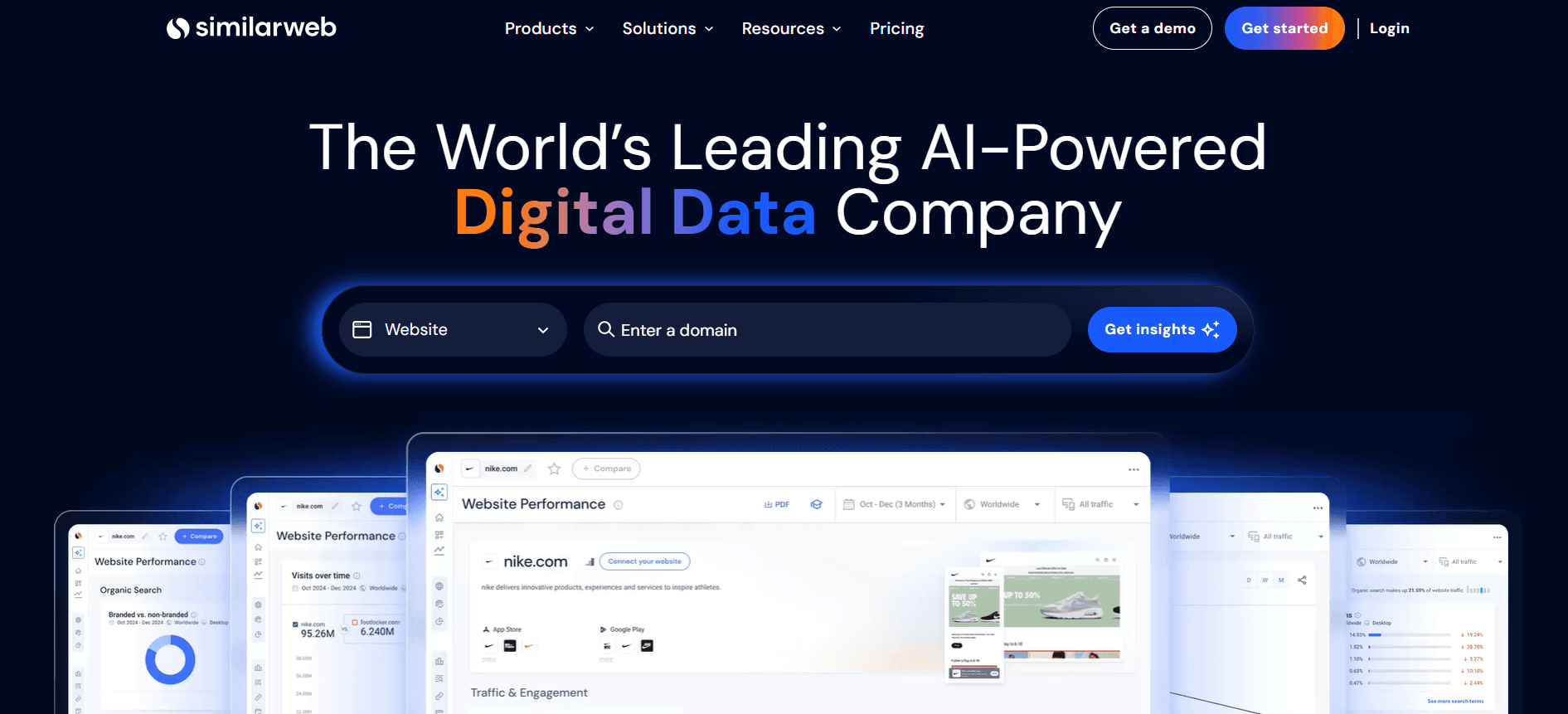
Similarweb provides site-level traffic trends, channel mix, and top landing pages, enabling you to see how competitors source visits across paid, organic, referral, social, and direct channels. Its blended data approach (panel data, public clickstreams, and direct measurement) gives strong macro signals to prioritize which channels to test first.
Core capabilities:
Website traffic trends and channel mix (search, paid, social, referrals, direct) plus top landing pages.
Market and category benchmarks, share-of-voice analyses, and API options for scaled reporting.
Team-level Competitive Intelligence packages for deeper analysis and reporting.
How Similarweb analyzes competitors:
Similarweb combines multiple traffic sources (panel data, public clickstreams, and direct measurement where available) to estimate visits, traffic sources, and referral pathways. That helps you select channels with actual volume before testing.
Best for:
Best for macro-level channel prioritization and share-of-voice; estimates for low-traffic sites can be noisy. Plan costs trend higher for full-featured competitive packages.
Pricing:
Custom packages. Similarweb offers free trials, starter Web Intelligence plans (around $125–$199/month), mid-tier Professional and Competitive Intel bundles ($333–$540/month), and custom enterprise plans with API and team features.
8. Pathmatics
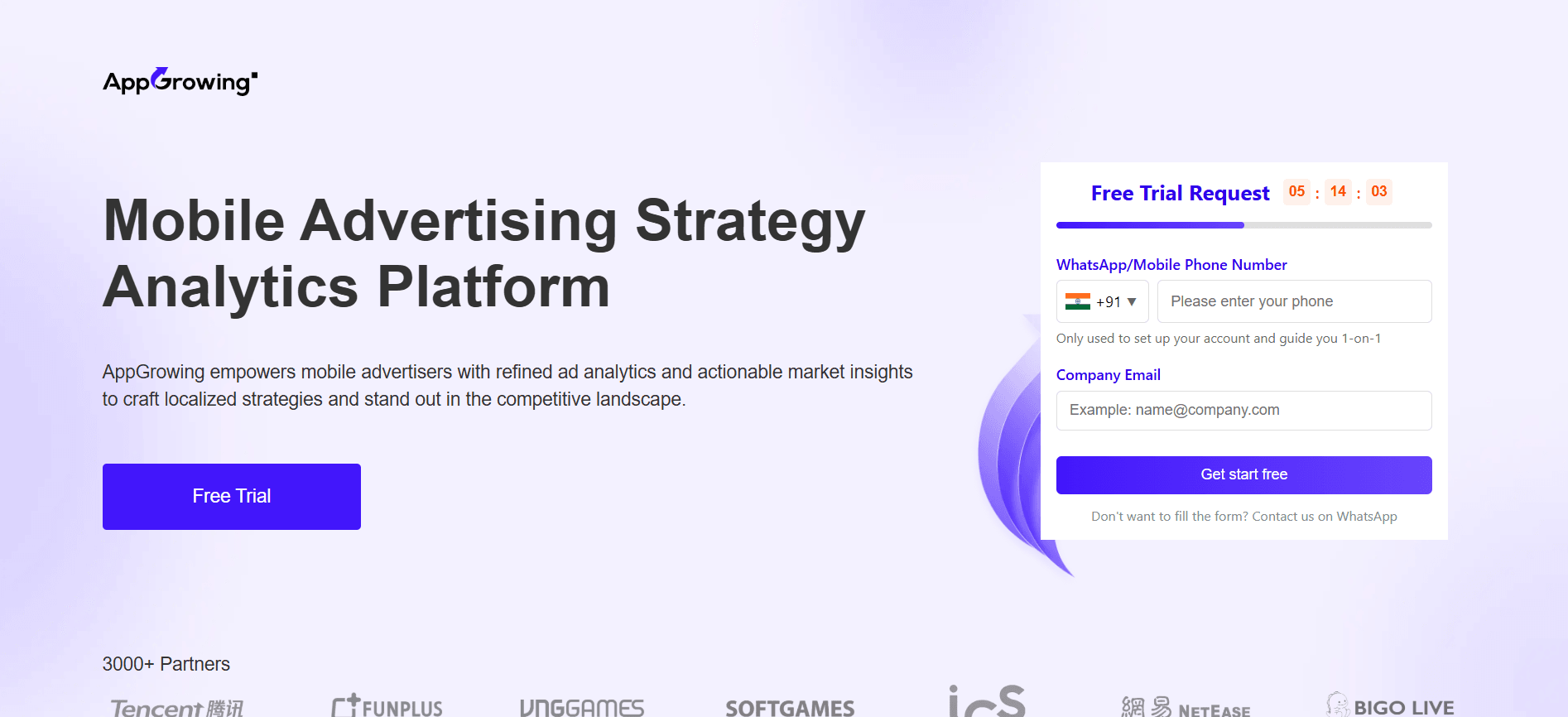
Pathmatics (now part of Sensor Tower Suite) provides cross-channel ad intelligence with spend and impression estimates, creative archives, and publisher-level placement data so teams can see who’s buying what, where, and for how long.
Core capabilities:
See current and historical ad spend and impression estimates across social, display, video, and mobile channels.
Access full creative assets and metadata messaging, CTAs, audience profiles, site/publisher targeting, flighting, and creative language detection.
Share-of-Voice and category benchmarking with side-by-side competitor and channel views.
Seasonal and historical trend reporting to inform media planning and budget allocation.
Publisher and placement visibility that links creatives to where they actually ran (useful for buy-type and placement decisions).
How Pathmatics analyzes competitors:
Pathmatics combines a sensor-network approach and proprietary data pipelines to capture ad creatives, impressions, and inferred spend across multiple platforms and publishers. The system assigns creatives to publishers and placements, aggregates impressions and spend estimates over time, and highlights creative and audience signals so you can compare tactics and timing across brands and channels.
Best for:
Marketing and media teams require ad-level spend and placement visibility across multiple channels to effectively prioritize tests and buys.
Brands and agencies are doing cross-channel competitive benchmarking and Share-of-Voice reporting.
Teams that require historical trend analysis to plan seasonal budgets and product launches.
Pricing:
Pathmatics is sold via demo and custom plans rather than a public tier list; interested teams request a demo or contact sales for quotes.
With several solid options available, apply a few quick checks to make sure a tool aligns with your channels, update cadence, and budget.
Also Read: Top Creative Analytics Tools for Successful Ad Campaigns 2025
How to Choose the Right Competitor Analysis Tool
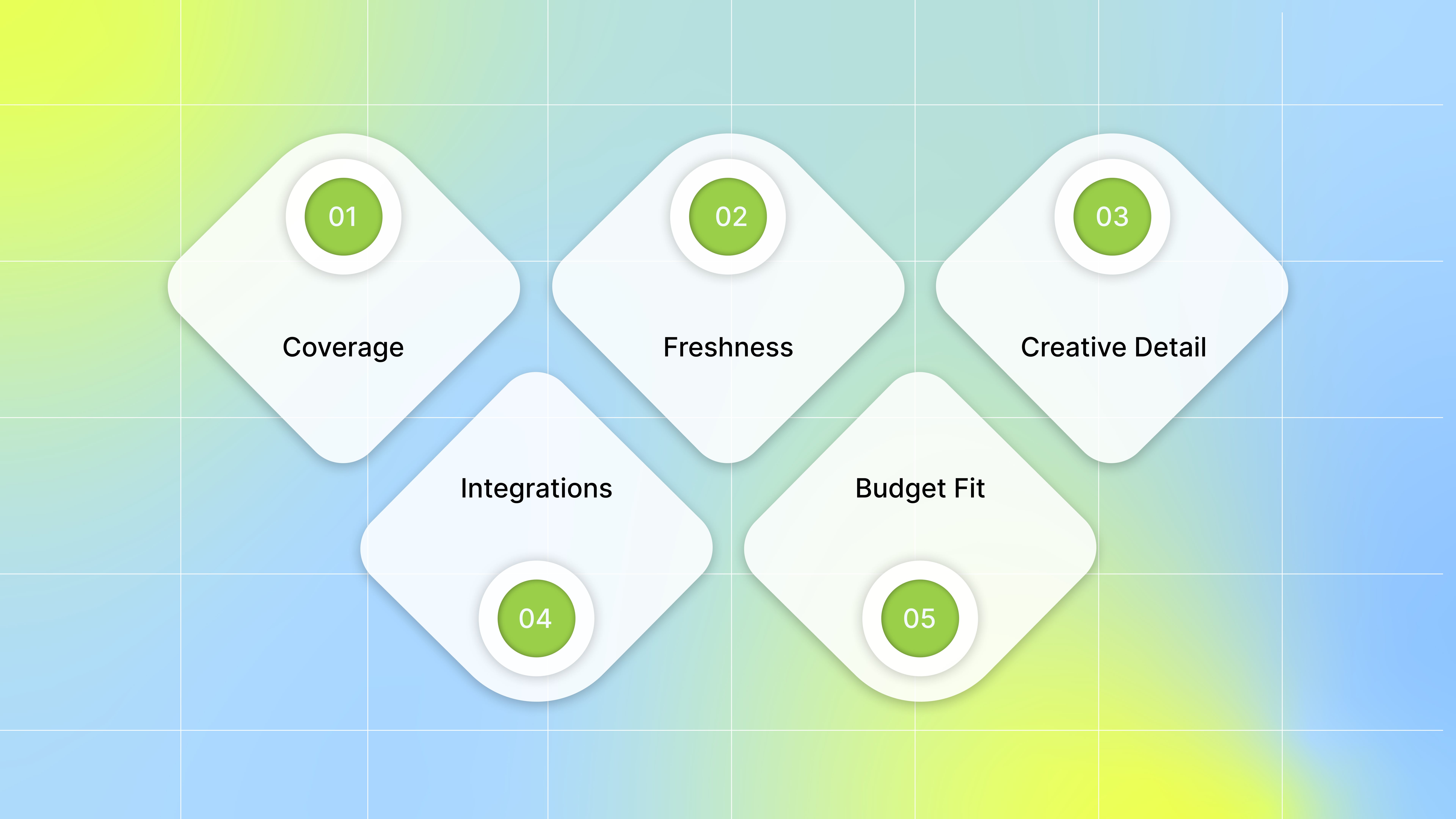
When you look for a tool for competitor ad analysis, you want clear answers fast: which channels your rivals use, how fresh the data is, what the creative looks like, how it fits into your reporting, and whether the price makes sense. Below are five simple checks you can run before you buy:
Coverage (Does It Track the Channels You Care About?): Check the list of ad channels the tool monitors. Look for explicit support for search, display, native, and social formats, and confirm it shows the exact ad types you care about (text search ads, banner/programmatic display, native in-feed, social placements, app-store placements).
Freshness (How Often the Data Updates and How Much History It Keeps): Find the update cadence (hourly, daily, weekly) and pick a tool whose cadence matches how fast you iterate. If you need near-real-time Meta monitoring, look for products that continuously scan the Ad Library and show a recent rolling window of creatives.
Creative Detail (Does It Capture Creatives, Landing Pages, and Metadata?): You want the ad creative, playable assets, or full screenshots, landing-page snapshots (or downloadable copies), run dates, and any detected copy/CTAs so your team can reliably recreate tests. Rate options based on the creative types captured, landing access, and metadata completeness.
Integrations (Will It Plug Into Your Reporting and Test Systems?): Look for API access, scheduled CSV exports, webhook support, and ready connectors for your data warehouse or BI tools so competitor signals join your performance data. Request a sample export during the trial to confirm that field names match your requirements.
Budget Fit (Public Pricing Versus Expected Value): Compare plan tiers to the exact features you will use. Define 2–3 measurable outcomes for a 30–90 day pilot (faster creative cycles, fewer wasted bids, clearer channel mix) and compare the projected gains to license cost. A shortcut: estimate the monthly wasted spend or time a feature will save and compare that to the price.
Pick the tool that helps you see what truly works, not just what’s visible on the surface. The right fit gives you clear creative insight, timely data, and smooth reporting so every ad test moves with purpose backed by real evidence instead of guesswork.
Once you pick a tool, you’ll need a repeatable way to turn findings into tests.
How to Use Competitor Analysis Tools in Your Workflow
Use this focused four-week plan to seamlessly integrate competitive benchmarking into your regular workflow, eliminating the need for extra meetings or added pressure. It’s built to help you turn competitors' actions into clear, testable ideas that strengthen your creative decisions and improve campaign outcomes over time.
Week 1: Pick Tools and Set a Baseline
Day 1–2 (Map your current process): Write down how you now spot rivals’ ads, which sources you check, and how many hours the team spends on it. This short audit provides a clear “before” picture, allowing you to measure improvement later. Keep the notes concise; what matters is time spent, channels checked, and handoffs.
Day 3–4 (Pick clear goals): Name the top two things you want from competitive data: creative ideas, placement lists, spend clues, or audience signals. Limit yourself to two outcomes to keep the tool choice and setup focused. Different products excel in different areas; match the tool to the outcome.
Day 5–7 (Choose and set up your tools): Pick one primary tool for regular monitoring and, if needed, one specialist tool for deep dives (for example, one that archives landing pages or one that scores creatives). Create accounts, add competitors, and set basic filters for geography and channels. Start with a brief list of competitors to expand upon later.
Week 2: Connect Sources and Collect a Baseline
Day 8–10 (Build your competitor list): Identify 5–10 direct rivals and 2–3 aspirational brands to monitor closely. That range gives a signal without noise: too many brands dilute useful patterns. Tag each competitor with a short reason for watching them (e.g., “testing promo offers” or “heavy video spend”).
Day 11–12 (Link platforms and data): Connect any supported ad platforms, landing-page trackers, or feed sources the tools offer. Use guided setup flows, but tune filters for the geography and the ad formats you run most. Confirm the tool captures creatives, run dates, and landing snapshots, as these fields are the most useful in tests.
Day 13–14 (Let the tools gather baseline data): Give the system several days to collect history before changing campaigns. This creates a “normal” view you can compare against after you act. If the tool offers timelines or change logs, use them to see how long ads have been running and which creatives are being reused.
Week 3: Alerts, Training, and First Analysis
Day 15–17 (Set alerts): Create notifications for meaningful moves: new campaigns, creative swaps, or sudden spikes in activity. Start with broad thresholds to keep your inbox from filling up. Refine alerts as you see which ones lead to useful tests. Automated change alerts and daily summaries can replace manual checks.
Day 18–19 (Train the team): Show the team where to find the dashboard, how to pull a one-page example, and the new steps for planning creative tests from competitive examples. Incorporate the process into your regular sprint or planning meeting to avoid extra work. Tools that score creative elements or suggest variants make handoffs smoother.
Day 20–21 (Run your first review): Compare current activity to the baseline and list 3–5 concrete opportunities (for example: a hook to test, a placement to try, or a landing tweak). Prioritize ideas that are cheap to test and quick to learn from. Capture the hypothesis, the test design, and the expected outcome in one line each.
Week 4: Tighten the Workflow and Measure Impact
Day 22–24 (Refine how you work): Remove noisy alerts, retain signals that regularly produce tests, and simplify the handoff to ensure findings enter live experiments quickly. Keep only the competitor tags and filters that produce repeatable value.
Day 25–26 (Build simple reports): Create a one-page template outlining the changes, tactical recommendations, tests to run, and expected impact. Use the same format each week so stakeholders learn the layout and decisions become faster. Short, repeatable reports beat long custom decks.
Day 27–28 (Define how you’ll measure ROI): Pick a small set of KPIs to track the value of competitive intelligence: time-to-insight (how long from spotted idea to test launch), percentage of tests that started from competitor signals, and lift in the measured campaign after the test (CTR, CVR, or CPA changes). Track these weekly for the first 90 days to see whether the workflow is paying off.
Run the plan, track the few KPIs you picked, and keep what produces real tests and results. After a month, you’ll have a repeatable process that turns competitor signals into quick, usable experiments and a clear way to show the value of the effort.
Also Read: How to Build a Competitor Dashboard for Insights
Conclusion
Competitor ad analysis isn’t just about observing others; it’s about using those insights to make smarter, faster campaign decisions. With AI tools now handling tasks that previously took hours, teams can easily identify creative patterns, test ideas with intention, and refine messaging based on real data rather than guesswork. The right tool turns competitive insights into practical actions that strengthen strategy and steadily improve ROI.
If you want to see what your competitors are testing and quickly find creative opportunities, Segwise makes it simple. It uses multimodal AI to automatically tag creative elements such as hooks, characters, CTAs, and emotions, then connects those tags to performance data through no-code integrations with major ad platforms and Mobile Measurement Partners (MMPs). It even flags fatigue or unusual performance, allowing teams to focus their testing where it matters most.
Segwise offers a free trial to explore its analytics and integrations, and its Competitor Ad Tracker stays completely free, making it an easy way to keep up with the latest competitor strategy.
FAQs
1. Is competitor ad analysis legal in the US?
Yes, monitoring public ads and posts is generally allowed, but avoid scraping private data or making misleading claims about competitors; get legal advice if you plan risky uses.
2. Can you reuse a competitor’s exact ad or tagline?
No, you can borrow ideas, but copying exact text, images, or using a rival’s trademark in a way that confuses customers can cause legal trouble.
3. What security questions should you ask a vendor before sharing data?
Ask about SOC2/ISO27001 or similar certifications, data retention and export rules, ownership of exports, and their incident-response history to confirm safe handling of your data.
4. Will competitor ad analysis tools also track influencers and organic posts?
Some tools only index paid ads, while others combine paid ad data with social listening to capture both influencer and organic content. Check each vendor’s coverage before you buy.
5. Will these tools replace your creative team?
No, they speed up research and idea generation, but you still need people to shape brand voice, judge concepts, and decide what to run.
